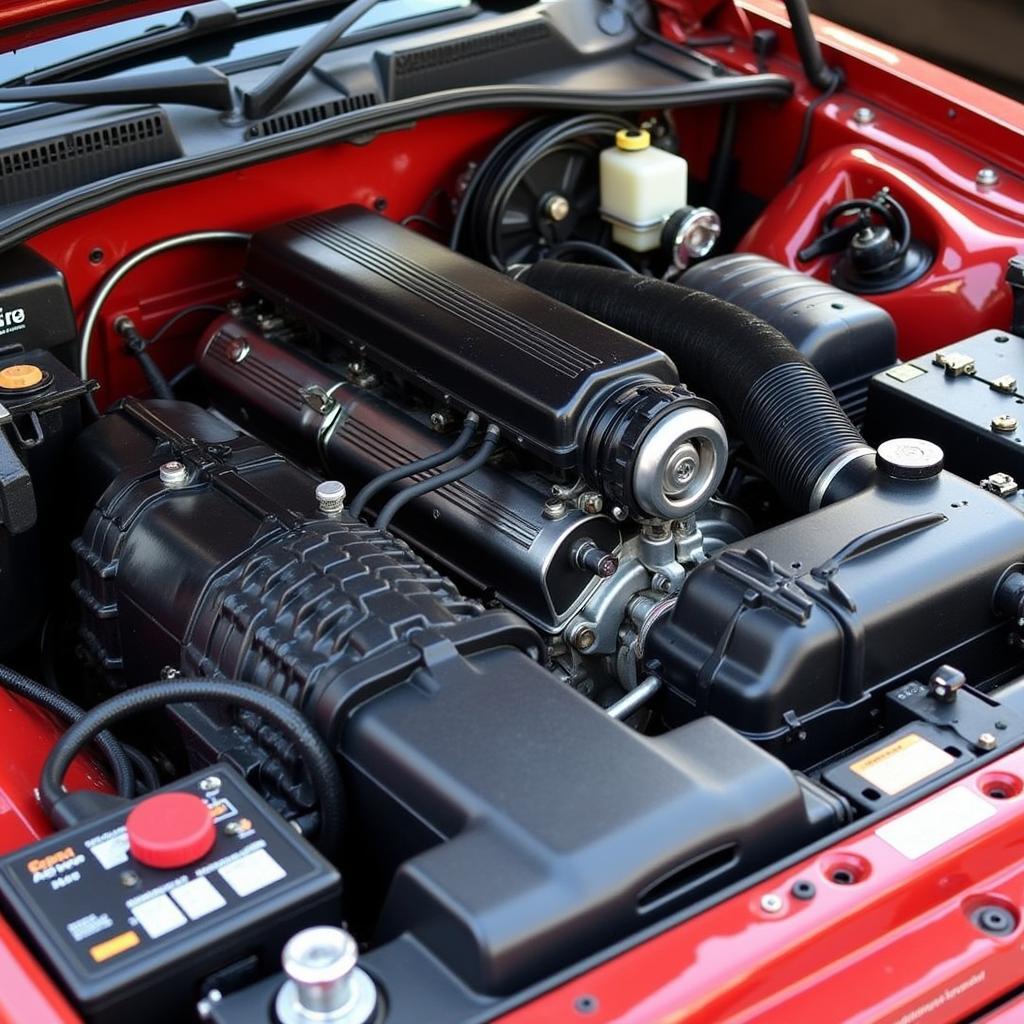A clean engine bay not only looks impressive but also can help with preventative maintenance. Knowing How To Detail Car Engine Bay effectively can protect your vehicle’s components and enhance its resale value. This guide provides a comprehensive step-by-step approach for achieving professional-level results at home.
Preparing Your Engine Bay for Detailing
Before you begin, ensure the engine is cool to the touch. Safety is paramount when working with car engines. Disconnect the negative battery terminal to prevent any accidental electrical shorts. This is a crucial first step. Cover sensitive components like the alternator, distributor (if applicable), and any exposed electrical connections with plastic bags and secure them with tape. This will protect them from water and cleaning solutions.
Cleaning the Engine Bay
Start by removing any loose debris, leaves, and twigs using compressed air or a detailing brush. For heavier grime, use a degreaser specifically designed for engines. Apply it liberally to all surfaces, avoiding direct contact with sensitive components that you’ve covered. Let the degreaser dwell for the recommended time according to the manufacturer’s instructions.
Rinse the engine bay thoroughly with a low-pressure water stream. Avoid using high-pressure washers, as the force can damage delicate components and push water into areas where it shouldn’t be. A garden hose with a spray nozzle works perfectly. Pay attention to hard-to-reach areas and crevices, ensuring all traces of degreaser are removed.
Detailing the Engine Bay
Once the engine bay is clean, you can begin detailing. Use a dedicated engine bay dressing to protect and enhance the appearance of the various components. Apply the dressing evenly using a microfiber applicator pad, avoiding overspray on belts and hoses.
For plastic and rubber components, use a specialized trim restorer to revitalize their appearance and protect them from UV damage. Apply it sparingly and buff off any excess with a clean microfiber towel. This will leave the plastics and rubber looking like new.
Finishing Touches
After the dressing and trim restorer have dried, inspect the engine bay for any missed spots or areas that need further attention. Wipe down any excess product and ensure all surfaces are clean and dry. Reconnect the negative battery terminal.
 Final Engine Bay Detail
Final Engine Bay Detail
Similar to how to detail classic car engine bay, meticulous attention to detail is crucial for a pristine result. This detailed process will leave your engine bay looking showroom-ready.
Maintaining Your Detailed Engine Bay
Regular maintenance is key to keeping your engine bay looking its best. Wipe down any spills or dirt immediately with a damp cloth. Consider using a quick detailer spray for regular cleaning between full detailing sessions. This will help prevent grime buildup and maintain the shine. Remember, regular upkeep will save you time and effort in the long run.
Conclusion
Learning how to detail car engine bay is a valuable skill for any car owner. It not only enhances the aesthetic appeal of your vehicle but also promotes its longevity. By following these steps, you can achieve a professional-looking finish and protect your engine from the elements. So, grab your detailing supplies and give your engine bay the attention it deserves. Remember, a clean engine bay is a happy engine bay!
FAQs
-
How often should I detail my engine bay? Detailing your engine bay every 6-12 months is generally recommended, depending on driving conditions and environmental factors.
-
Can I use a pressure washer to clean my engine bay? While it’s possible, it’s best to avoid high-pressure washers. They can force water into sensitive areas and cause damage.
-
What type of degreaser should I use? Use a degreaser specifically formulated for engine bays. Avoid harsh chemicals that could damage plastic and rubber components.
-
Is it safe to detail my engine bay myself? Yes, as long as you follow the safety precautions mentioned, such as disconnecting the battery and covering sensitive components.
-
What are the benefits of detailing my engine bay? Detailing helps prevent corrosion, improves the appearance of your engine, and can make it easier to spot potential leaks or issues.
-
Can detailing my engine bay increase my car’s resale value? A clean and well-maintained engine bay can definitely contribute to a higher resale value.
-
What should I do if I get water in a sensitive area? Dry the area thoroughly as quickly as possible. If necessary, use compressed air to help remove any trapped water.
If you’re unsure about any aspect of the process, particularly when detailing the paint engine bay on a scale model car, it’s best to consult a professional detailer. You can find more information about car detailing by checking out our article on why is car cleaning called detailing.
For those interested in detailing model cars, consider our guides on how yo detail paint engine bay on model car and how to detail paint engine bay on scale model car. For classic car owners, we also have a guide on how to detail classic car engine bay.
If you need professional car detailing services, check our prices at how much to get my car detailed in 85248.
Need assistance? Contact us via WhatsApp: +1(641)206-8880 or Email: [email protected]. Our customer support team is available 24/7.

Leave a Reply